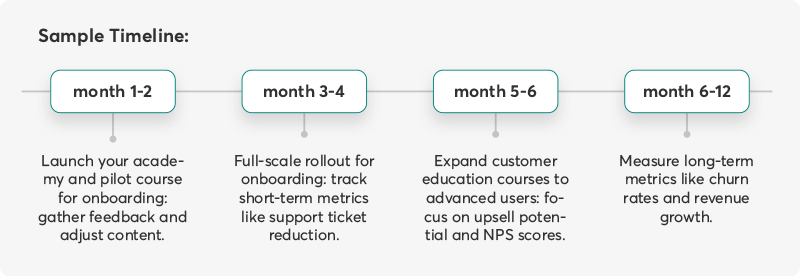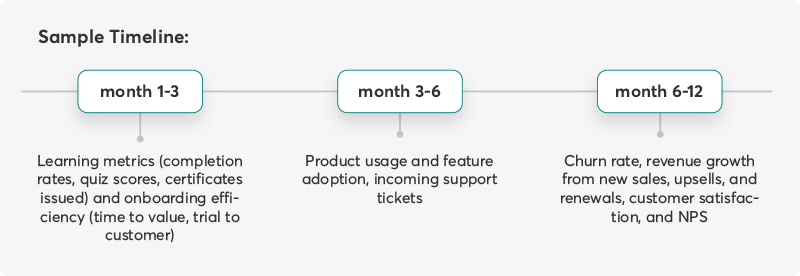Table of Contents
Securing buy-in for a customer education program can feel like an uphill battle. Customer education initiatives are often deprioritized due to conflicting priorities, perceived difficulty, and unclear ROI.
What if we told you that a well-prepared pitch can make all the difference in securing the much-wanted buy-in? If you manage to demonstrate the value of customer education and present management with an easy-to-implement plan, your chances of success dramatically increase.
This blog is the third in our series focused on securing customer education buy-in, aiming to help you craft a convincing case and present it confidently in front of stakeholders. To get the full scoop, download our free ebook How to build your case for customer education and win executive buy-in.
Pitching customer education: an action checklist
We have previously discussed How to identify customer education needs and Why Leadership objects to customer education.
Now, we’re sharing an easy-to-follow checklist to ensure your proposal is clear, actionable, and aligned with your company’s business goals. With the proper preparation, you’ll have everything you need to win over stakeholders and make customer education a priority.
Step 1: Link customer education to business strategy
Clarify how a customer education initiative serves one or more business goals and is aligned with the overall business strategy. For example, if the company is running marketing campaigns to boost lead generation, present customer education as an additional way to increase brand awareness and attract new customers.
If available, present stakeholders with industry reports that support your case and examples of competitors and other brands that achieved their business goals with customer education.
Example: “By launching a course in our customer education academy that covers advanced product features, we expect to increase upsell revenue by 15% in the next 12 months, based on our analysis of customer usage patterns and feedback.”
💁Read our article 7 Effective Customer Education Examples & Best Practices for 2025 to see examples of companies who have found success through customer education.
Step 2: Create SMART business goals
Use the SMART methodology to create measurable goals; SMART goals bring structure and manage expectations. Therefore, they can serve as selling points for your program and can be used as benchmarks to measure the program’s effectiveness.

Example: “Increase the customer onboarding completion rate by 20% within the next 3 months by launching a 5-part video course series that covers key features and provides interactive quizzes. This will lead to a reduction in customer support queries by 15%.”
How to create a SMART business goal
Predicting the numbers for SMART goals in a customer education program can be challenging but possible. One rule of thumb is to set incremental goals and adjust them as you go and have a better understanding of the impact. Apart from that, you can also:
By combining these strategies, you’ll be well-equipped to set realistic and impactful SMART goals to support your pitch while setting a solid foundation for a successful program.
Step 3: Start with a high-impact pilot and expand
Propose a phased rollout rather than a full-scale launch. Begin with a high-impact pilot, such as improving onboarding or addressing a frequent support issue, and build from there. This not only simplifies execution but also delivers early results, which you can use to justify further investment.
Example pilot: Develop an onboarding course that reduces support tickets for first-time users by 20% within the first 6 months. Use this success to demonstrate the broader potential of customer education.

LearnWorlds is a scalable platform that allows you to start small and expand as you grow. Explore our plans and choose the one that best meets your current needs. Start for free now, with no strings attached.
Step 4: Propose a customer education team
To create an effective customer education program, it’s essential to start with a detailed plan outlining who should be involved and how each team will contribute.
By defining roles and responsibilities early on, it’s easier to estimate the resources needed, streamline task delegation, and keep all stakeholders informed and aligned.
The roles and departments typically involved in customer education initiatives are:
Step 5: Provide a tech solution
Do your research and choose one or two LMS providers (customer education platforms) that best match your requirements. Doing so will help you prepare a more accurate cost-benefit analysis and answer the million-dollar question of how the program will be built and delivered.
Our advice is to choose a flexible LMS that will enable you to start small and scale your operations as your business grows and your needs are redefined and evolve. Aim for a balance between feature availability and reasonable pricing.
💡Our RFP template will guide you through the LMS selection process, helping you ask targeted questions to evaluate potential vendors. Get it for free now.
Step 6: Prepare a cost-benefit analysis
Collaborate with your finance department to prepare a cost-benefit analysis to minimize concerns about ROI and unexpected expenses. Here’s some information you’ll need to provide them with:
Building a detailed cost-benefit analysis is a powerful way to secure a budget for customer education and monitor progress after the rollout. By clearly outlining costs and potential returns, you provide stakeholders with a comprehensive view of the value customer education can bring to the business.
Step 7: Set a measurement framework
It’s helpful to have a measurement framework in place to evaluate the business impact of your customer education program. Your measurement framework should include the following:
1. Target segment
Identify the audience segment, based on:
2. SMART business goal/program objective
Define a goal that is:
3. Business metrics
Determine the most meaningful metrics, such as:
💁 Learn more about the key metrics to measure the success of your customer education program in our article How to Measure Customer Training ROI: 15 KPIs to Keep an Eye on
4. Data collection methods
Use tools and channels like:
5. Timeframe for the first review
Set a date for the initial assessment to track outcomes.
6. Reporting frequency
Decide on a regular schedule for reporting and analysis to continuously refine the program.
Step 8: Allow for a realistic time frame
Although setting a realistic time frame is part of your SMART goal setting, this also needs to be clearly addressed and pointed out to management during your presentation.
Customer education doesn’t bring results overnight, so you don’t want to overpromise and create unrealistic expectations that will come back to haunt you. Allow for at least one quarter before you come back to measure results.
Here’s a rough breakdown:

Step 9: Welcome follow-up meetings
After presenting your case, give stakeholders time to reflect and align the proposal with their goals. Offer follow-up meetings to address questions, gather feedback, and adjust your plan. Clear communication and flexibility are key to securing a strategic win.
Marketing techniques to make a strong case
Getting the buy-in for customer education is essentially a marketing activity. As such, it doesn’t hurt to deploy some proven marketing strategies that, let’s admit, we have all fallen for—besides, it’s for a good cause.
So, here, we’ll share some marketing strategies. And, in case you still get a no for an answer, we have also prepared a role-playing scenario with possible objections and ways to respond.
Time to get the green light
Building a strong pitch for customer education takes preparation, insight, and a focus on measurable outcomes. By aligning your proposal with business objectives and addressing concerns head-on, you can turn skeptics into supporters.
Use the strategies outlined here to show leadership how customer education not only benefits customers but also drives real business results. With the right approach, you’ll have the tools to make customer education a priority for your organization.
Further reading you might find interesting:

Androniki Koumadoraki
Androniki is a Content Writer at LearnWorlds sharing Instructional Design and marketing tips. With solid experience in B2B writing and technical translation, she is passionate about learning and spreading knowledge. She is also an aspiring yogi, a book nerd, and a talented transponster.

